There’s something funky going on at Gotta Go Ranch.
Redford and Rocky
I’m not sure what it is, but all the horses are going through big changes in their feet. Take Redford and Rocky for instance. They just got back from the Mt. Carmel XP ride. Rocky rode 50 miles and Redford rode 100 miles. They both had their Glue-On boots on for seven days and they both shed about 1/4 inch of sole with the boot removal. This is a first to see so much sole come off on these two horses at once – and really nice to see so much concavity under there finally.
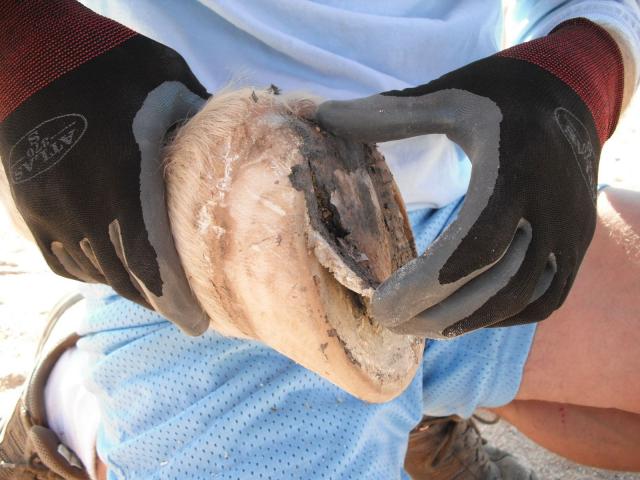
Redford: you can see the remnants of the Goober Glue, but just look at the amount of sole he is shedding. The concavity is looking much better and he wasn’t tender afterwards.
Since spending time with Duncan McLaughlin in early April, we’ve been more focused on bringing the toe back every week. I wonder if there is a relationship between bringing the toe back; reducing the stretch effect forward on the sole and frog by doing this; and a resulting release of material? Maybe we could entice a hoof care practitioner to chime in on this one.
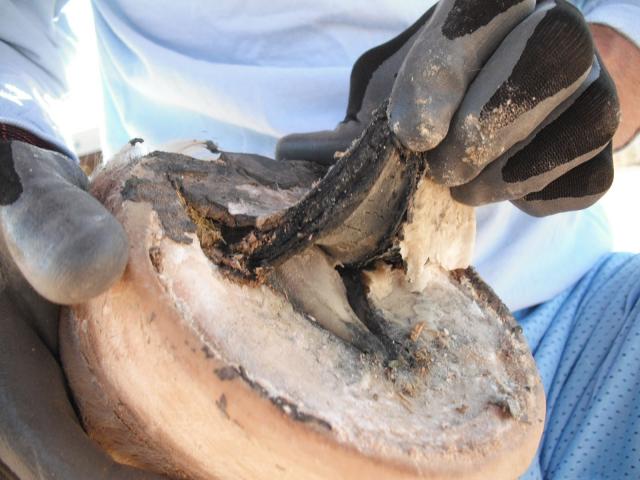
The frog is sloghing too. The Goober Glue over the frog is actually quite thin –
this is all almost exclusively frog that is peeling off.
I must say that 11 months into the transition, Redford has never felt so sound as he feels today. He does show some signs of tenderness from time to time, even after the most conservative of trims, but he has never felt this good going down the trail. He is also pointing his front feet much less than he did before. I do believe this horse is now comfortable. And that makes me happy.
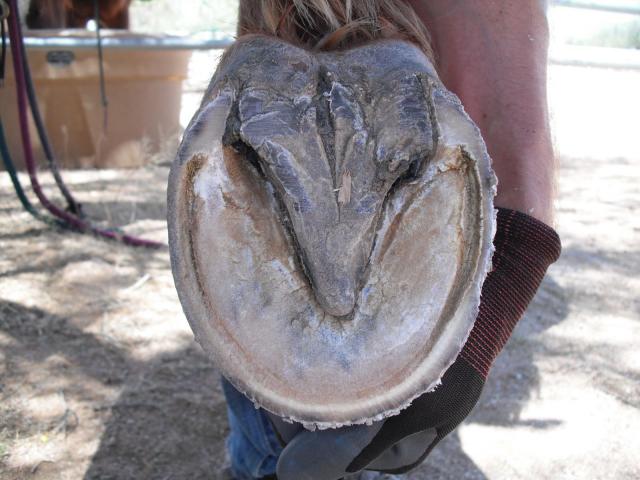
Redford’s front left with an incomplete trim. I like the changes: the hoofwall
separation continues to reduce – albeit slowly.
Ricky Bobby
I applied Glue-Ons to Ricky Bobby’s front feet last week – partly to show the latest easy application methods, and partly because he was showing ongoing signs of being tender. I don’t like to leave Glue-Ons on for more than a week to ten days – even in the arid conditions of the Sonoran Desert, so I took the boots off yesterday.
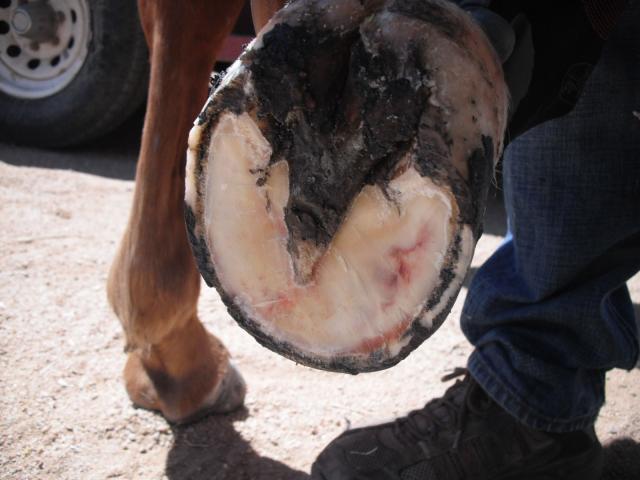
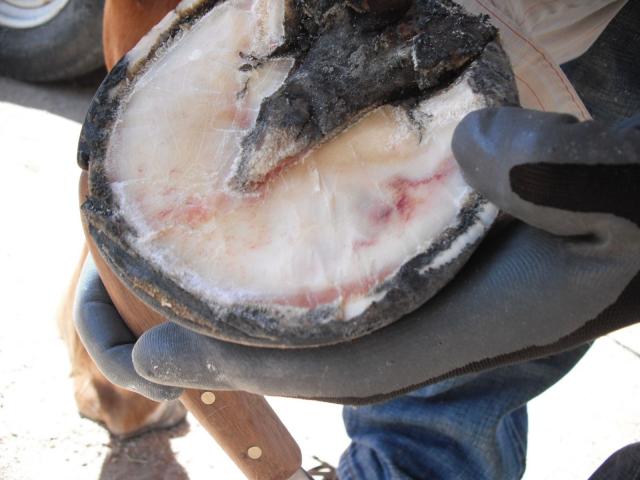
Ricky Bobby’s front right after the Glue-On shells were removed and the sole gently
peeled away with a knife. That bruising must hurt.
He is also shedding sole – and revealing the reason for his tentativeness on harder ground. He is definitely turning out to be the most challenging of the horses we have transitioned. Look at what is going on under there.
He is much more comfortable today – the sole is just slightly inferior to the hoof wall and the frog is still taking pressure, so I’m happy with his progress. But you can see full well that this is going to take a while to grow out properly. You can also see that he popped an absess last week while I was gone on his right hind. He’s not sore on it.
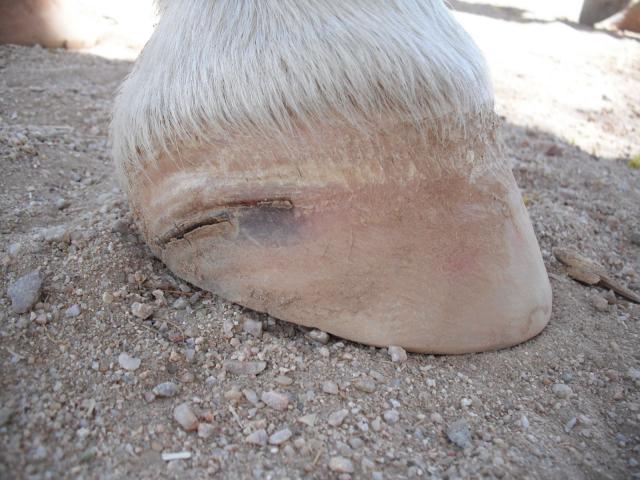
I’ll keep you posted. Keep up the bootlegging!
Kevin Myers

Director of Marketing
I am responsible for the marketing and branding of the EasyCare product line. I believe there is a great deal to be gained from the strategy of using booted protection for horses, no matter what the job you have for your equine partner.





My interpretation:
Backing up toe is a part of it. In effect, the toe backup caused the horses to be excessively solar loaded. This is not ideal; ‘ideally’ the weight is spread over all portions of the hoof: frog, soles and walls ( and ideally the sole is slightly passive to the INNER wall – which should be the main weight-bearing structure when standing on concrete) around the whole hoof circumference), but necessary to correct break-over and get the hoof pivoting at the correct point. It also assists in moving the coffin bone higher in the hoof, by shifting it higher relative to the wall, and can grow in a tighter connection.
Applying goober glue in the sulci/on the sole, further increases this solar loading.
After some time in this solar loaded state, the hoof says: holy smoke – too much solar pressure here – better dump me some sole. So the sole exfoliates and the sole becomes concave and again slightly passive to the inner wall but now the wall is a better (shorter) length, has a tighter coffin bone connection, and more functional pivot point and break-over.
So looking at your photos. Your ’separation’ at the quarters isn’t separation – the wall is simply too long there. This can be now be addressed by taking the heels down to where they should be: ie, there should only be a tiny (‘ideally’ something like 1mm deep) gap between the level of the frog and the level of the heel. You couldn’t do this earlier because the feet were not ready for it. They were not ready because:
1. When you shorten the toe to any significant degree, you then force a heel first landing. This is what the EB Glove/Glue-on do. Yes they make the horse more comfortable but it is the location (excellent) of the boot break over relative to its solar surface, combined with increase momentum from the weight of the boot, that encourages horses to go heel first booted.
2. Forcing a heel first landing when the horse doesn’t have the internal structures to deal with moving that way (ie, developed dig cushion and ungual cartilages) then the horses will get heel sore and then start toe first landing – obviously need want to avoid this! In the transitioning horse, lowering heels transfers loading from the existing heel wall/buttresses area to the frog/digital cushion/ungual cartilages, so needs to be done carefully. Walk and trot the horse out while you make these heel adjustments. Goober Glue is such a powerful assist in this process, you can lower the heels but use its cushioning to take the stress off those internal structures. A dome pad for the glove would do the same!!
Once you have the toe approaching where it should be and you get the heels lowered, then the heels correctly expand on landing, the wall at the quarters is abraded with heel movement and you lose those long walls at the quarters (looking like separation :-).
I say all this in an authoritive way only because I have seen it a bazillion times. In fact, the only time you don’t regularly see it is with arena horses working on a sand – that abrades away the sole during the ongoing process, so the concavity is always apparent. This process is also how we can rehab serious acute laminitis back to riding soundness in one hoof capsule: sure it is not ideal to dump these poor horses onto their soles either but it is the quickest route to fix them.
Comments are closed.